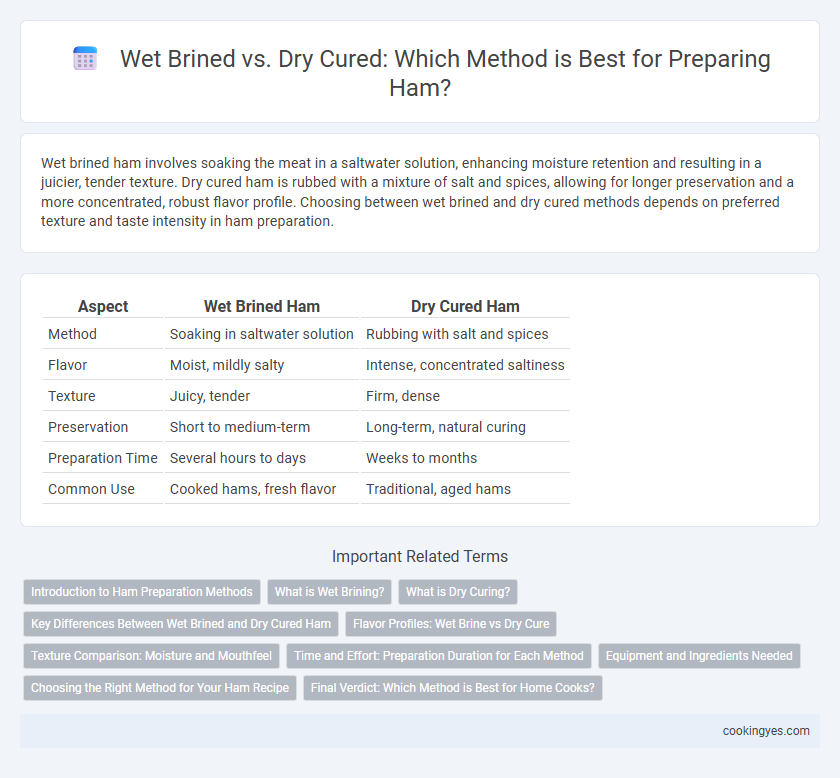Wet brined ham involves soaking the meat in a saltwater solution, enhancing moisture retention and resulting in a juicier, tender texture. Dry cured ham is rubbed with a mixture of salt and spices, allowing for longer preservation and a more concentrated, robust flavor profile. Choosing between wet brined and dry cured methods depends on preferred texture and taste intensity in ham preparation.
Table of Comparison
| Aspect | Wet Brined Ham | Dry Cured Ham |
|---|---|---|
| Method | Soaking in saltwater solution | Rubbing with salt and spices |
| Flavor | Moist, mildly salty | Intense, concentrated saltiness |
| Texture | Juicy, tender | Firm, dense |
| Preservation | Short to medium-term | Long-term, natural curing |
| Preparation Time | Several hours to days | Weeks to months |
| Common Use | Cooked hams, fresh flavor | Traditional, aged hams |
Introduction to Ham Preparation Methods
Wet brined ham involves submerging the meat in a saltwater solution, enhancing moisture retention and ensuring a tender, flavorful result. Dry cured ham is treated with a salt-based rub that draws out moisture, concentrating flavors and creating a firmer texture. Selecting between wet brining and dry curing depends on desired taste, texture, and preservation needs in ham preparation.
What is Wet Brining?
Wet brining for ham preparation involves submerging the meat in a solution of water, salt, sugar, and sometimes spices to enhance moisture retention and flavor. This method allows for even salt distribution, resulting in a juicier and more tender ham compared to dry curing. The process can take several days, depending on the size of the ham and desired flavor intensity.
What is Dry Curing?
Dry curing involves coating the ham with a mixture of salt, sugar, and spices, allowing the meat to cure through osmosis while drawing out moisture to enhance flavor and preservation. This traditional method typically requires several weeks to months, resulting in a denser texture and concentrated taste compared to wet brined hams. Renowned dry-cured hams such as prosciutto and Jamon Iberico showcase the technique's ability to develop complex, rich flavors without the use of liquid solutions.
Key Differences Between Wet Brined and Dry Cured Ham
Wet brined ham involves soaking the meat in a saltwater solution infused with herbs and spices, resulting in a juicier and more tender texture due to moisture retention. Dry cured ham uses a mixture of salt, sugar, and seasonings directly rubbed onto the meat, promoting a denser texture and concentrated flavors through dehydration and longer aging. The wet brining process typically shortens curing time, while dry curing requires extended aging to develop complex, robust flavors.
Flavor Profiles: Wet Brine vs Dry Cure
Wet brined ham offers a moist, tender texture with a mildly salty flavor enhanced by aromatic herbs and spices absorbed during soaking. Dry cured ham develops a more concentrated, robust taste due to salt drawing out moisture, intensifying natural pork flavors alongside a slightly chewy texture. Flavor profiles differ significantly as wet brining adds subtle seasoning depth, while dry curing delivers a complex, savory richness with firm bite.
Texture Comparison: Moisture and Mouthfeel
Wet brined hams retain higher moisture content due to saltwater absorption, resulting in a juicier texture and tender mouthfeel. Dry cured hams undergo moisture loss through salt curing, producing a denser, firmer texture with concentrated flavors. The choice between wet brined and dry cured directly impacts the ham's succulence and chew, influencing overall eating experience.
Time and Effort: Preparation Duration for Each Method
Wet brined ham requires immersion in a saltwater solution for 5 to 10 days, demanding consistent temperature control and occasional solution refreshment. Dry cured ham involves applying a dry salt mixture and aging for several weeks to months, necessitating dedicated space and precise humidity management. The wet brining process generally consumes less time but higher daily monitoring, whereas dry curing demands longer preparation with less frequent attention.
Equipment and Ingredients Needed
Wet brined ham preparation requires a large container for submerging the pork in a saltwater solution, along with curing salt, sugar, water, and optional flavorings such as garlic, bay leaves, and peppercorns. Dry cured ham involves rubbing the meat with a mixture of curing salt, sugar, and spices, necessitating curing racks or hooks for air-drying in a controlled environment with consistent temperature and humidity. Essential equipment for wet brining includes a refrigerator or cool space to maintain brine temperature, while dry curing demands a curing chamber or a well-ventilated, cool room for proper moisture loss and flavor development.
Choosing the Right Method for Your Ham Recipe
Wet brined hams absorb moisture by soaking in a saltwater solution, resulting in a juicier and more tender texture, ideal for recipes requiring a softer bite. Dry cured hams rely on rubbing salt and spices directly onto the meat, creating a firmer texture with concentrated flavors, perfect for thin slicing or serving as a charcuterie component. Selecting the right method depends on the desired moisture level, flavor intensity, and end use of the ham in your culinary preparation.
Final Verdict: Which Method is Best for Home Cooks?
Wet brined hams retain more moisture and deliver a juicy, tender result ideal for home cooks seeking a straightforward preparation method with consistent flavor. Dry cured hams develop a deeper, more intense taste and firmer texture, making them well-suited for those who prefer traditional, artisanal flavor profiles. Choosing between wet brined and dry cured largely depends on personal preference for moisture level and taste complexity in ham preparation at home.
Wet Brined vs Dry Cured for Ham Preparation Infographic

 cookingyes.com
cookingyes.com